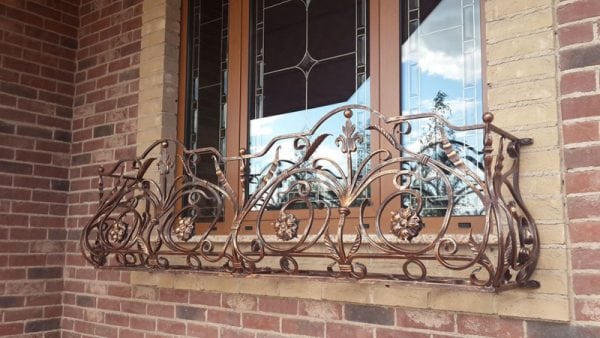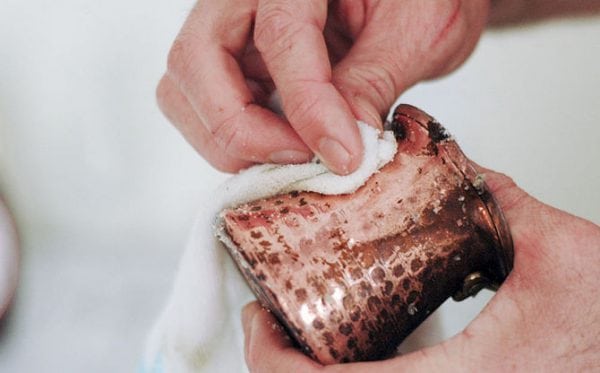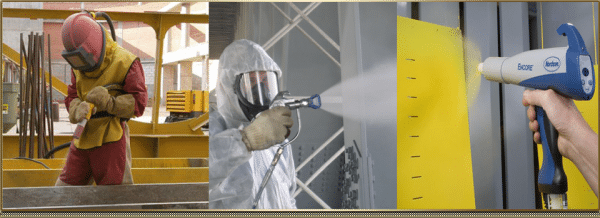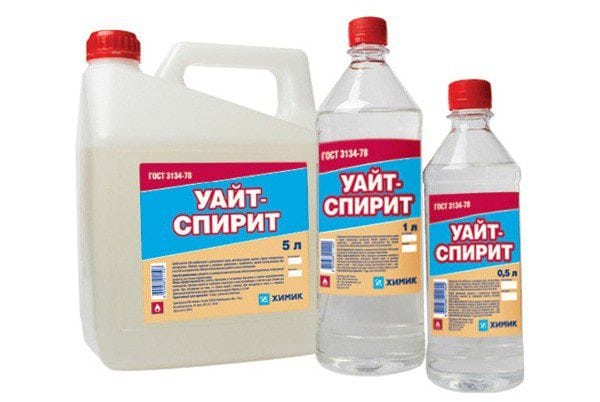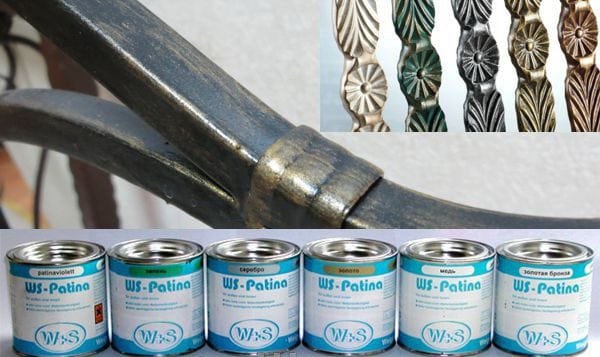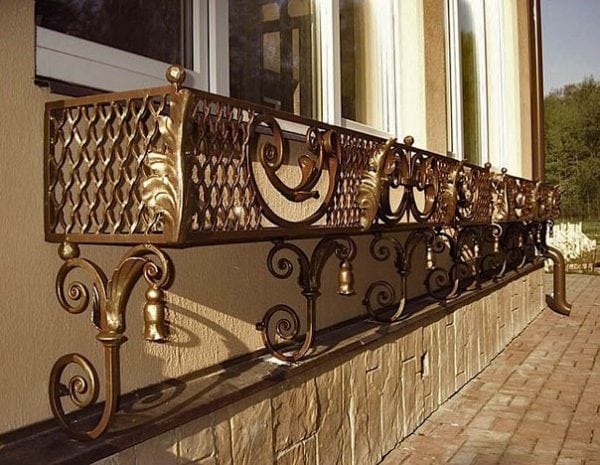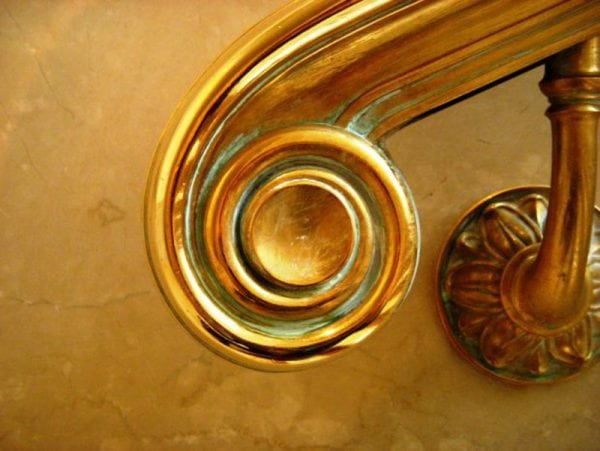Metal products are susceptible to environmental influences and especially humidity. You can protect the metal with the help of special anti-corrosion coatings (for example, covering the surface with zinc), as well as by painting. The paint performs not only the role of a protector against corrosion, but gives the surface a more aesthetic appearance.
- Surface preparation
- Padding
- Putty
- The choice of paint for metal
- Blacksmith paints
- Metal painting
- Bronze staining
- Antique staining
- Staining and low temperatures
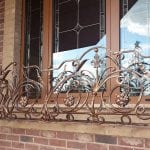
Decorative metal painting allows you to simulate a wide variety of effects. For example, you can decorate the surface in bronze, silver or give the metal an aged noble appearance. How to choose a paint and varnish material, prepare the base and apply paint to it, will be discussed below.
to contents ↑Surface preparation
First of all, you need to evaluate the strength of the old coating. The masking tape will help in this: we make incisions on the old paint and glue the tape to these places. Then, with a sharp movement, we tear off the tape. If a significant amount of paint separates after the tape, the surface is not strong enough. If the layer is strong, then it is not necessary to remove it, it is only necessary to clean the metal from dirt, traces of rust and dust.
Note! If we are talking about heating batteries, the old paint must be removed, because in this case, each additional layer reduces heat loss.
Surface cleaning (metal, walls, etc.) can be carried out in one of three ways:
- mechanical (using abrasives or tools);
- chemical (using alkaline formulations or active solvents);
- thermal (using a hot air gun or an oxygen-acetylene burner).
Padding
Primer treatment is necessary to create a reliable bond between metal and paint. Primers are made on the basis of synthetic or natural film-forming substances (organic resins, drying oils, etc.).
An important property of primers is to reduce the likelihood of corrosion. Depending on the type of primer, the mechanisms for providing corrosion protection differ.
There are several types of primers according to the nature of their anticorrosion properties:
- Isolating. Such primers do not allow moisture to get on the protected metal.
- Passivating. The action of passivating compounds is based on a decrease in the electrochemical activity of the material.
- Tread. Such primers contain highly dispersed metal powders in which the electrode potential is lower than that of the protected metal. This provides protection against corrosion.
- Phosphating The phosphate coating protects the metal from corrosion.
- Inhibitory. An inhibitor is a substance that reduces the rate of development of chemical reactions. Since rust formation is the result of a chemical reaction, inhibitory primers reduce the rate of development of corrosion processes.
- Rust Converters. Rust converters convert iron oxide to an insoluble compound.
The primer is applied with a brush, roller, swab or spray. The primer should not be too thick - thinner than subsequent layers of paint.The optimum thickness of the primer is up to 0.1 millimeters.
If the primed surface is matte, it must be carefully cleaned with fine-grained sandpaper. This will improve the adhesion to the paintwork material.
to contents ↑Putty
Putty is necessary to eliminate defects such as cracks, as well as to smooth the surface. A putty compound is a mixture of filler (chalk), a plasticizer, a binder, and special additives.
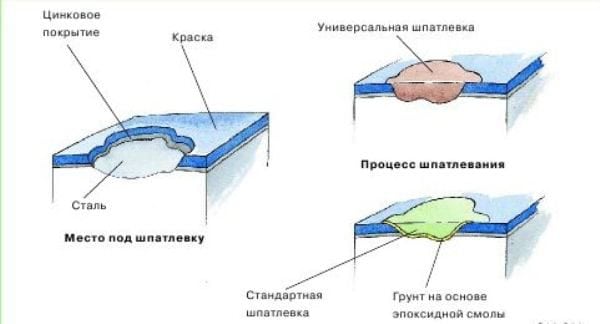
Putty mixes are sold in one of two states - dry (diluted in water) and ready to use (diluted in a solvent). The putty is applied and spread over the surface with a spatula.
to contents ↑The choice of paint for metal
For painting metal surfaces, organically soluble paints and varnishes are most often used. Such solutions are a mixture of synthetic alkyd resins and organic solvents. As the most commonly used white spirit or styrene.
After drying of the alkyd compounds, thick, durable, transparent, almost colorless films appear. Such films are resistant to all kinds of chemicals, as well as moisture. Due to the latest quality, alkyds are widely used not only indoors, but also outside buildings.
However, when choosing a composition, you should pay attention to the recommended purpose of the paint. For example, special compositions are produced for coloring batteries that have high thermal conductivity and do not reduce the heat transfer of the equipment.
to contents ↑Advice! It is recommended to opt for materials (primer, putty, paint) from one manufacturer. In this case, there is no risk of incompatibility of the chemical compositions.
Blacksmith paints
For a long time, staining has not been applied to forged metal. There was a generally accepted opinion that the paint eliminates the advantage of manual work, hides the natural texture of the material.
However, not so long ago, paints and varnishes for forged products appeared that allow you to artificially age the material, create the appearance of a patina or achieve other visual effects. Forge paints also protect metal from corrosive processes.
The main disadvantage blacksmith paints - their cost. Like the creation of forged products, specialized paints cannot be called cheap.
to contents ↑Metal painting
You can apply paint using a brush, roller or spray gun. The number of layers required for painting is set by the manufacturer and depends on the opacity of the paint. Hiding power is the ability of a paint and varnish material to hide the color of the surface being treated. The hiding power is inversely proportional to the transparency of the paintwork material, that is, the more transparent the paint, the more it will be needed.
Note! Hiding power is indicated on the package with paint and is determined in the consumption of material per square meter.
Difficulties may arise when calculating the required amount of paint material. Manufacturing companies provide information on consumption per square meter. When it comes to painting flat surfaces, it is not difficult to calculate the flow rate. However, it is often necessary to deal with uneven surfaces - gratings, fences, curly details, etc. In such cases, the calculations will have to proceed from your own experience or the advice of the seller.
to contents ↑Bronze staining
Decorating the surface under bronze has been used for a long time. However, until recently, such paints were made on the basis of organics.Thus, the scope of use of such paints and varnishes has narrowed significantly due to the unpleasant odor characteristic of organic solvents. Moreover, such surfaces are not resistant to temperature extremes.
To date, the most popular paints based on water and acrylic. Such compositions are distinguished by safety, ease of use, resistance to high and low temperatures, as well as corrosion resistance.
There are two ways to decorate a bronze surface. Below are two step-by-step instructions.
The first option is plain coloring:
- We remove dirt and traces of rust from the surface. We carry out degreasing.
- Primed the surface. This will improve the adhesive properties of materials and, in addition, create a layer of polymer that protects the surface from corrosion.
- When the primer is dry, apply bronze paint in 2-3 layers. Moreover, each layer can be applied only after the previous one dries.
The second option is aged bronze:
- We carry out preparatory activities as described in the first case. Then we ground the metal and paint it in bronze color.
- Depressions on the surface are treated with a patina. It can be translucent - this will allow you to control the level of dimming.
- When the paint dries, take a dry brush and glaze. To do this, apply light paint at the corners and protrusions in such a way as to create the effect of scuffs.
- After the layer dries, we apply a transparent varnish to the metal.
Antique staining
You can give the metal an aged look in another way, using craquelure primer and paint.
Instruction:
- We clean metal from dirt, traces of rust and grease.
- We cover the cleaned and dry surface with a paintwork material. For staining, we use a brush, since an uneven coating in this case is only for the benefit.
- When the paint is completely dry, apply a craquelure primer. This compound can be purchased at a hardware store. After drying, a transparent polymer film will appear on the surface.
- We create the main craquelure coating. The result is aged metal with traces of rust. Moreover, small cracks - craquelures - will appear on the surface.
Staining and low temperatures
Recommends to paint surfaces at positive temperatures. It is believed that the minimum allowable temperature is 5 degrees above zero. However, there are situations when you need to paint the surface urgently, despite the thermometer. And in this case, high-quality staining is possible if you adhere to a number of recommendations, which will be discussed below:
- We clean the surface of ice, dust, dirt, rust and condensate. Moreover, standard cleaning procedures - mechanically - in this case will not be enough. Even if only a little condensation remains, all further efforts will not allow to create a high-quality coating. To dry the surface well, use a burner (gas or gasoline) or a heat gun.
- At low temperatures, the paint will dry 2-3 times longer. Based on this, it is necessary to protect the painted surface from environmental influences. For this, a plastic film and a heat gun are suitable.
Equally important for painting at low temperatures is to choose the right paint. The best option is jelly-like alkyd enamels. Such compositions are characterized by high adhesive qualities.

